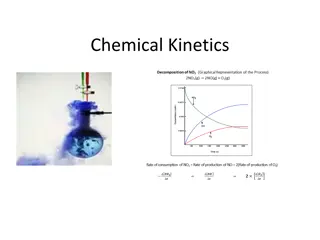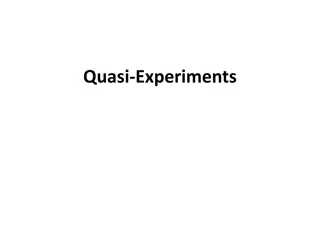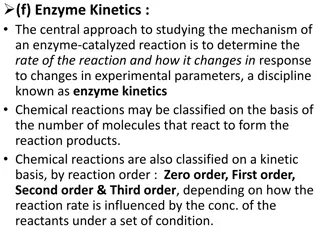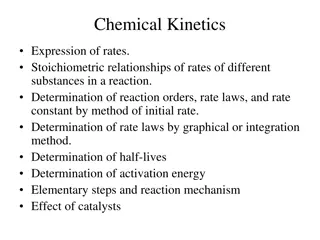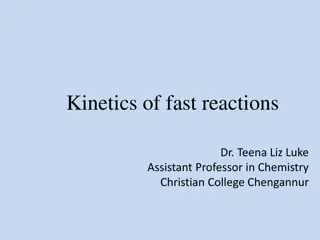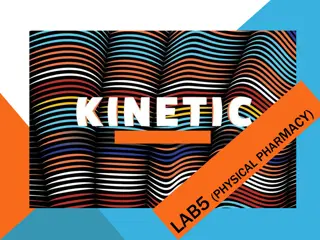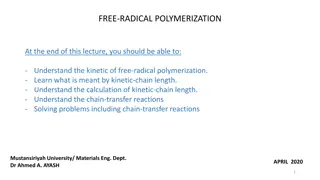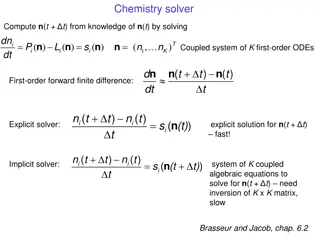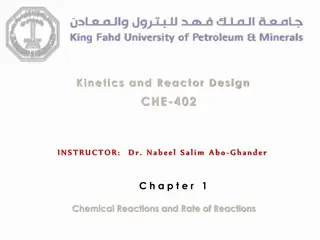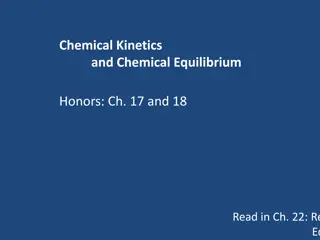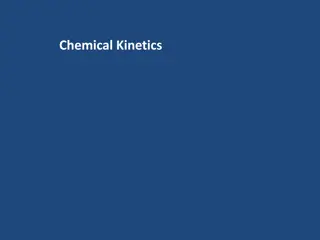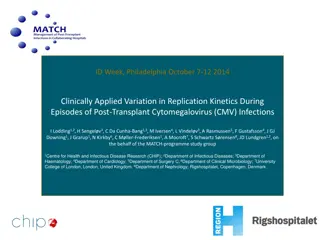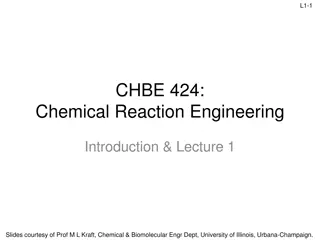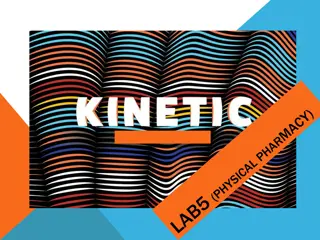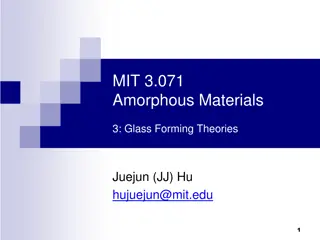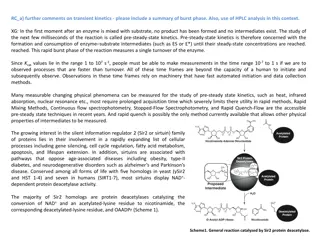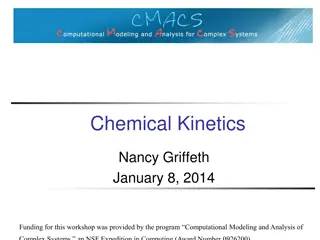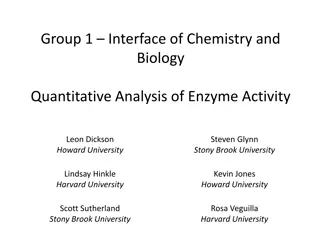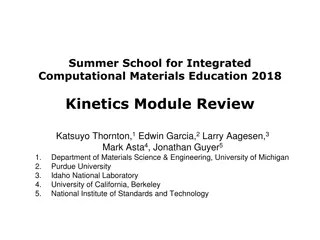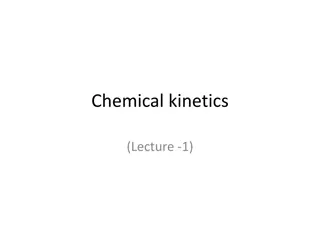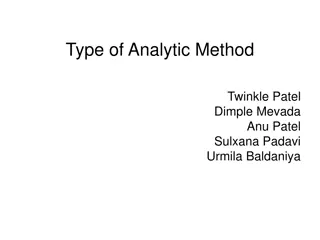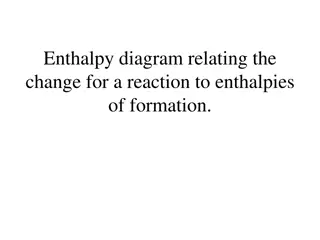Aspen Simulation of Steam Reforming and Haber-Bosch Processes in Kinetics Reactors
Aspen simulation showcases the kinetics reactors for steam reforming of natural gas and the Haber-Bosch process for ammonia production. Steam reforming is highly endothermic, producing hydrogen and CO, while the Haber-Bosch process is exothermic, crucial for ammonia synthesis. The RPlug reactor and
5 views • 26 slides
Chemical Kinetics: Understanding Reaction Rates and Factors
Chemical kinetics is a branch of physical chemistry that explores the velocity and factors influencing chemical reactions. It studies how reactants transform into products, considering conditions like temperature, pressure, and reactant concentrations. Factors affecting reaction rates include the na
8 views • 24 slides
Chemical Kinetics: Rates of Reactions and Factors Influencing Them
Chemical kinetics delves into the speed of chemical reactions and the factors that influence reaction rates. This field explores how collisions between atoms, ions, or molecules drive chemical reactions, as well as the role of catalysts, reactant concentration, temperature, and surface area. By unde
0 views • 32 slides
Quasi-Experiments in Research
Quasi-experiments are research studies that resemble experiments but do not involve random assignment of participants to treatment groups. This approach is taken when random assignment is challenging or when ethical considerations come into play. Unlike true experiments, quasi-experiments can provid
2 views • 15 slides
Enzyme Kinetics for Understanding Chemical Reactions
Enzyme kinetics is a vital discipline focusing on the rate of enzyme-catalyzed reactions and how they respond to varying conditions. Reactions are classified based on reactant concentration influences. Zero, first, second, and third order reactions are distinguished, with examples like first-order r
0 views • 31 slides
Chemical Kinetics: Rates, Reactions, and Mechanisms
Chemical kinetics involves studying reaction rates, rate laws, stoichiometry, and factors affecting reaction speed. This branch of chemistry delves into determining reaction orders, rate constants, and activation energies using various methods. Different types of rates, such as initial, instantaneou
5 views • 68 slides
The Kinetics of Fast Reactions in Chemistry
Kinetic methods involve measuring analytical signals under dynamic conditions to study fast reactions in chemistry. This study explores the various methods used, such as Flow Method and Stopped Flow Method, to determine reaction rates accurately. Advantages of the Stopped Flow Method over Continuous
1 views • 18 slides
Kinetics and Reaction Rates in Chemistry
Kinetics is the study of reaction rates and factors affecting them, such as concentration, temperature, catalysts, and more. Orders of reaction classify reactions based on rate dependency on reactant concentration. Factors like pH, light, and solvents can also impact reaction rates. Half-life and sh
0 views • 18 slides
Free Radical Polymerization Kinetics
This lecture covers the kinetics of free radical polymerization, including initiation, propagation, termination, and kinetic chain length concepts. It explains the calculation of kinetic chain length and chain-transfer reactions. Key points include the rate equations for initiation, propagation, and
0 views • 11 slides
Introduction to Kinematics and Dynamics of Machines in Mechanical Engineering
Theory of Mechanics delves into motion, time, and forces, with Kinematics focusing on motion analysis without considering external forces. Kinetics, a branch of Theory of Machines, deals with inertia forces resulting from mass and motion. Dynamics combines Kinematics and Kinetics to study motion and
1 views • 14 slides
Factors Affecting Enzyme Activity and Kinetics Experiments
Explore the factors influencing enzyme activity, such as substrate and enzyme concentration, temperature, pH, and inhibitors. Learn how to simulate enzyme kinetics using equipment like popping beads and stopwatches. Analyze results to understand the impact of substrate concentration on reaction rate
0 views • 22 slides
Chemical Kinetics: Reaction Rates and Mechanisms
Chemical kinetics is a branch of chemistry focused on studying reaction rates and mechanisms. Unlike thermodynamics, which deals with feasibility, kinetics explores the speed at which reactions occur. Factors such as temperature, pressure, and catalysts influence reaction rates. Understanding the ra
4 views • 72 slides
Reactor Sizing: Conversion, Selectivity, and Kinetics Overview
Understanding reactor design involves considerations such as desired conversion, selectivity, and kinetics. Key concepts include rate laws, molar balances, and reactor types. Through molar balance equations and reactor design processes, one can derive essential equations for ideal batch, CSTR, and P
2 views • 20 slides
The Objectives of Online Laboratories in STEM Education
Online laboratories offer interactive experiments over the internet, providing remote and virtual practical experiences in STEM education. The OpenSTEM Labs project aims to explore various activities and outcomes in experiments, focusing on classification schemes and learning objectives. The purpose
0 views • 17 slides
Chemical Kinetics and Numerical Solvers in Chemistry
Explore the principles of chemical kinetics and the use of numerical solvers to compute concentrations over time, considering explicit and implicit methods. Understand stability and positivity requirements in solvers and the importance of characteristic time scales in chemical systems. Dive into a s
0 views • 5 slides
Fundamentals of Chemical Kinetics and Reactor Design
Explore the realm of chemical reactions, rate equations, and reactor design in this informative chapter. Understand the factors influencing reaction rates, different types of reactions, rate laws, and experimental determination of reaction rates. Dive into examples illustrating stoichiometry and rat
0 views • 19 slides
Overview of Chemical Reactor Design and Operation
Chemical reactor design involves studying the rates and mechanisms of chemical reactions, as well as the design of reactors for these reactions on a commercial scale. This field combines principles from thermodynamics, chemical kinetics, fluid mechanics, mass transfer, heat transfer, and economics t
0 views • 12 slides
The Interface to the Current CCPP: A Simple Model's Perspective
This content explores the interface to the current CCPP from a simple model's viewpoint, focusing on two simplistic schemes - kinetics and chem_solve. It delves into how the MusicBox simple driver model adapts chemical species using temperature and rate constants. Users can control the run sequence
0 views • 9 slides
Chemical Kinetics and Equilibrium in Reactions
Explore the basic concepts of reaction rates, collision theory, activation energy, and energy diagrams in chemical kinetics and equilibrium. Learn how particles must collide with the correct orientation and enough energy to form an unstable activated complex. Discover the role of activation energy i
0 views • 24 slides
Chemical Kinetics: The Rate of Reaction and Equilibria
Chemical kinetics explores the rate at which chemical reactions occur and the factors influencing them. This tutorial delves into the concepts of reaction rates, equilibrium, collision theory, and the role of concentration in determining reaction rates. By understanding these principles, industries
1 views • 117 slides
Chemical Kinetics: Reaction Rates and Activation Energy
Exploring the fundamental concepts of chemical kinetics, this content delves into reaction rates, collision theory, and activation energy in chemical reactions. It emphasizes the importance of particle collisions, correct orientation, and energy requirements for reactions to occur. Through energy di
1 views • 17 slides
Replication Kinetics in Post-Transplant CMV Infections
This study explores the variation in replication kinetics of Cytomegalovirus (CMV) during post-transplant infections. The aim is to assess the doubling time of CMV and evaluate the rationale behind weekly screening intervals in transplant recipients. Methods include analyzing CMV PCR samples and rev
0 views • 21 slides
Introduction to Chemical Reaction Engineering
Chemical Reaction Engineering (CRE) is crucial for understanding how chemical reactors operate in various processing operations. This field involves reactor design by integrating factors such as thermodynamics, kinetics, fluid mechanics, heat transfer, and economics. CRE aims to effectively design a
0 views • 16 slides
Kinetics in Chemical Reactions
Kinetics is the study of reaction rates and factors affecting them. Reaction rate is the speed at which a reaction occurs, influenced by factors like concentration, temperature, pH, light, catalysts, and solvents. Reactant concentration determines reaction order, which categorizes reactions as zero-
0 views • 18 slides
MIT 3.071 Amorphous Materials
Dive into the intricate world of glass formation, exploring theories, nucleation kinetics, thermodynamics, and crystallization processes. Discover the factors influencing the transformation from liquid to glassy state, and unravel the fundamentals of inorganic glasses through insightful readings. Ga
0 views • 28 slides
Overview of Pre-Steady-State Kinetics in Enzyme Reactions
Pre-steady-state kinetics is essential for studying transient stages in enzyme reactions, such as the burst phase. Techniques like rapid quench-flow and HPLC analysis provide insights into enzyme-substrate interactions. The Sir2 protein family, including SIRT1-7, plays crucial roles in cellular proc
0 views • 12 slides
Chemical Kinetics
Chemical kinetics is the study of reaction rates in chemical systems, influenced by factors like concentration, temperature, and catalysts. Explore various chemical and biochemical reactions, including the Law of Mass Action, reaction equilibrium, and deriving equilibrium values, through detailed ex
0 views • 24 slides
Quantitative Analysis of Enzyme Activity in Biochemistry
Dive into the fascinating world of enzyme kinetics with a focus on understanding and interpreting data through quantitative analysis. Explore the fundamentals of Michaelis-Menten kinetics, reaction rates, and experimental design to unravel the secrets of enzyme behavior in biological systems.
0 views • 17 slides
ENZYME KINETICS
In enzyme kinetics, the presence of specific enzymes accelerates reactions, with substrate conversion catalyzed swiftly and specifically. Enzyme units and specific activity play critical roles, impacting reaction rates and product formation. The Michaelis-Menten Equation explains enzyme behavior, wi
0 views • 19 slides
Nonlinear Regression in Chemical Kinetics Analysis
Nonlinear regression plays a crucial role in analyzing chemical kinetics, as seen in the application of the Michaelis-Menten model to Puromycin kinetics. The process involves modeling enzyme reaction velocities, linearizing the model for regression analysis, and deriving insights for further analysi
0 views • 23 slides
Advanced Study on PP/ABS Polymer Blends Crystallization Kinetics
Explore the development of polypropylene (PP) and acrylonitrile-butadiene styrene (ABS) blends, investigating the non-isothermal crystallization kinetics using various models. Understand the unique properties of PP and ABS, and the advantages of blending them to enhance impact properties while prese
0 views • 28 slides
Understanding Enzyme Inhibition and Its Kinetics
Learn about enzyme inhibitors and their impact on catalysis, the different types of reversible enzyme inhibition, including competitive and uncompetitive inhibition, and how they affect enzyme kinetics. Discover how these inhibitors work and their implications in drug design and biochemical studies.
0 views • 54 slides
Computational Materials Education: Kinetics Module Review
Dive into the Kinetics Module of the Summer School for Integrated Computational Materials Education 2018, exploring diffusion, semiconductor processing, computational tools, and more. Understand the driving forces behind diffusion and Fick's laws, with hands-on exercises and analytical solutions to
0 views • 20 slides
Chemical Kinetics Overview: Reactions, Rate Equations, and Order
Explore the fundamental principles of chemical kinetics, including reaction progress, reaction velocity, and rate equations. Discover the significance of studying reaction mechanisms and the utility of determining the correct mechanism. Learn about reaction rates, stoichiometry, rate equations, and
0 views • 18 slides
Chemical Reaction Rates and Factors Overview
Explore the concepts of slow, fast, and moderate chemical reactions, reaction rates, and stoichiometry in this comprehensive guide. Learn about reaction mechanisms, kinetics, and examples of different reaction rates. Understand the dynamics of very slow, fast, and moderate reactions with real-world
0 views • 15 slides
Principles of Analytical Methods for Enzyme Kinetics
Explore the principles of various analytical methods used in enzyme kinetics, including End Point Method, Kinetic Method, and Fixed-Time Kinetic Method. Learn how reactions between substrates and reagents form colored complexes, and how enzymatic reactions are measured based on substrate or enzyme c
0 views • 6 slides
Understanding Chemical Kinetics: Clock Reactions and Reaction Mechanisms
Explore the fascinating world of chemical kinetics through clock reactions and reaction mechanisms. Learn how the rate of a reaction is determined by its slowest step, and discover the concept of clock reactions where a visible change marks a specific point in the reaction. Delve into the formaldehy
0 views • 15 slides
Understanding Chemical Kinetics and Reaction Rates
Explore the fascinating world of chemical kinetics and reaction rates, from defining rates and measuring progress to standardizing reactions. Learn how concentrations change in chemical reactions and how reaction rates are calculated from concentration measurements over time.
0 views • 8 slides
Understanding Enthalpies of Formation and Chemical Kinetics
Explore enthalpy diagrams, enthalpies of formation, and chemical kinetics in this comprehensive guide. Learn how the change in reaction enthalpies relates to enthalpies of formation and delve into the rates of reactions and chemical kinetics to understand the speed of chemical processes over time.
0 views • 38 slides
Chemical Kinetics: Understanding Reaction Rates and Factors
Explore the fascinating realm of chemical kinetics and learn how reaction rates are influenced by factors such as temperature, concentration, and catalysts. Discover the importance of rate expressions and how changing reactant concentrations can impact reaction rates. Dive into examples and experime
0 views • 21 slides


